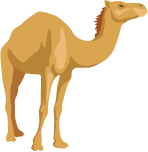The family
Camels and their babies
Milking
Some information

The reproductive cycle of a female lasts between 23 to 28 days

The estrus period of a female lasts from 4 to 6 days

The onset of puberty is at 2 years old

Females start breeding at 4 years old.

Sexual maturity is reached at 6 years old

The end of the reproductive career is between 20 and 30 years.

Gestation lasts 13 months.

At birth, the young weigh between 26 and 42 kg and are weaned after 10 to 12 months.

Lactation can last from 8 to 18 months.
Gestation of the dromedary :
It differs from the cow (which has a nine-month gestation) and is closer to the mare (with a gestation of twelve and a half months). The gestation period for the Bactrian camel (two humps) is a few days longer compared to the dromedary (one hump). There are about 2 years between two births. The optimal time for birth is between 12 p.m. and 5 p.m., and there is a 0.4% chance that a female will give birth to twins.
Birth of the young:
Some females give birth standing up, but usually, delivery happens in a squatting position. The breeder can assist by helping the female position herself during labor for an easier delivery and help her lie on her side. It is rare that a dromedary female needs help, but the breeder can facilitate the expulsion of the young by gently pulling on the front legs and assisting with the extraction of the head.
Immediately after birth, the mother approaches her young and sniffs it. The mother recognizes her baby by its scent.
Right after birth, the calf and its mother must stay together in a quiet place to develop a strong bond between them. The intake of colostrum contained in the mother’s milk during the first 24 hours is essential for the young to acquire passive immunity necessary for survival. Very rich in immunoglobulins, the colostrum protects the young against microbial attacks during the first weeks of life, before it can produce its own antibodies. The survival of camel calves during the first weeks is a major concern; the young is very fragile, sensitive to humidity, diseases, and other external disturbances.
Males are generally born larger. During the first weeks, a camel calf drinks on average 3 liters of milk per day.
Milking the camels :
The female camel, like all camelids, has four teats and therefore resembles the cow more than the mare. The calf can stay with its mother during lactation, which aligns more with the growing consumer demand for animal welfare.
Before milking: The calf suckles for about 30 seconds to stimulate the milk let-down reflex. The first jets of milk are extracted and checked for appearance to detect any possible pathologies. It is important to clean the teats with warm water and dry them with individual wipes to prevent disease transmission between animals.
During milking: It is essential that the animals are not stressed and accept to give their milk. The protocol is similar to that used for dairy cows, with a few particularities, but the calf is not separated from the mother. The female camel is less reluctant to give milk if her young is present and if the human-animal relationship is good.
Lactation can last from 8 to 18 months. The milk production of a female camel increases with the number of lactations.
Early developments after birth:

What do we do with
the milk?
- Fresh milk
- Powdered milk
- Kefir
- Cream
- Yogurts
- Soaps
- Cosmetic
- Medicinal products
With the participation of :
